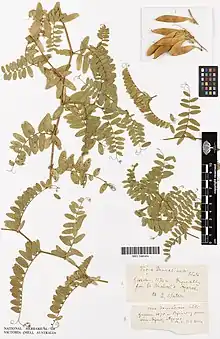Vicia dennesiana
Vicia dennesiana is a species in the Fabaceae family, named after the solicitor and plant collector George Edgar Dennes.[2] It is protected by the Bern Convention on the Conservation of European Wildlife and Natural Habitats.[3][4] This species has not been found in the wild since 1848, and is considered extinct in its natural habitat.[5][6] It has not been observed in cultivation since 1922.[7]
| Vicia dennesiana | |
|---|---|
 | |
| Scientific classification | |
| Kingdom: | Plantae |
| Clade: | Tracheophytes |
| Clade: | Angiosperms |
| Clade: | Eudicots |
| Clade: | Rosids |
| Order: | Fabales |
| Family: | Fabaceae |
| Subfamily: | Faboideae |
| Genus: | Vicia |
| Species: | V. dennesiana |
| Binomial name | |
| Vicia dennesiana | |
The habitat of the species is poorly known. The available data indicate that the species developed on the sheltered slopes of Serra da Tronqueira, São Miguel Island, Azores, but the population was subsequently destroyed in a landslide.[8][9]
A cultivated population was maintained in the Thames Ditton garden of Hewett Cottrell Watson, the author who described the species.[5] Several seeds were germinated and produced annually flowering and fruiting plants. In the winter, the plants were sheltered in a greenhouse to protect them from frost, and in the summer they were planted in the garden. However, at the end of May 1867, almost all of Watson's plants had died due to a late frost. One of the three surviving plants bloomed again in the summer of the next year, which made it possible to continue to cultivate the species.[2] After Watson's death a specimen was transferred to the Royal Botanical Gardens of Kew.[5] Due to unsuccessful propagation, today only herbarium specimens remain.[9]
Herbarium specimens
The Fielding-Druce Herbarium of Oxford University and the Kew Gardens Herbarium include specimens collected on Ilha de São Miguel.[10][11][12] Preserved specimens of Vicia dennesiana cultivated by Watson are held by herbaria including the National Herbarium of Victoria Royal Botanic Gardens Victoria, and the Copenhagen University Botanical Museum.[13][14]
References
- "Vicia dennesiana". International Plant Names Index. Retrieved 14 April 2021.
- Godman, Frederick Du Cane (1870). "Botany of the Azores". Natural history of the Azores, or Western Islands. London: J. Van Voorst. p. 155.
- "Vicia dennesiana. Espécies da Directiva Aves/Habitats 140/99 Diário República Anexo II. Plano Sectorial para a Rede Natura 2000 Açores" (PDF). Island Biology Research Group. 2000. Retrieved 12 April 2021.
- "Checklists containing Vicia dennesiana H.C.Watson". Natural History Museum. 2021. Retrieved 19 April 2021.
- Anonymous (1887). "Vicia dennesiana: Native of the Azores Islands". Curtis's Botanical Magazine. 3 (43): 6967.
- Schaefer, Hanno; Hechenleitner, Paulina; Santos-Guerra, Arnoldo; Menezes de Sequeira, Miguel; Pennington, R. Toby; Kenicer, Gregory; Carine, Mark A. (2012). "Systematics, biogeography, and character evolution of the legume tribe Fabeae with special focus on the middle-Atlantic island lineages". BMC Ecology and Evolution. 250 (12): 250. doi:10.1186/1471-2148-12-250. PMC 3547781. PMID 23267563.
- "Vicia dennesiana". Stockholms Universitet. 2019. Retrieved 26 April 2021.
- Board of Trustees of the Royal Botanic Gardens, Kew. "Vicia dennesiana". Plants of the World Online. Retrieved 26 April 2021.
- Britten, J. (1922). "Short Notes: Vicia Dennesiana H.C. Watson". Journal of Botany, British and Foreign. 60: 364.
- Marner, Serena (2014). "News from the Herbaria" (PDF). Oxford Plant Systematics. 20: 39.
- Museum of the History of Science. "Lost and Found". Natural Histories. Retrieved 23 June 2021.
- JSTOR. "Vicia dennesiana". JSTOR Global Plants. Retrieved 26 April 2021.
- "The Australasian Virtual Herbarium". The Australasian Virtual Herbarium. Council of Heads of Australasian Herbaria (CHAH). 2020. Retrieved 12 April 2021.
- GBIF. "Vicia dennesiana". Global Biodiversity Information Facility. Retrieved 26 April 2021.